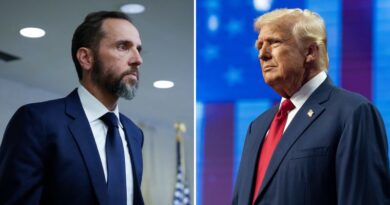The election is over, but Ron Johnson keeps promoting false claims of fraud.

Two days after the Electoral College confirmed President-elect Joseph R. Biden Jr.’s victory, a Senate committee provided a platform on Wednesday for another round of specious legal arguments and falsehoods about widespread voter fraud that have been repeatedly rejected by courts across the country.
The hearing was the latest effort by the Republican chairman of the homeland security committee, Senator Ron Johnson of Wisconsin, to amplify the claims and concerns of President Trump. Mr. Johnson previously used his committee to investigate Mr. Biden’s son, Hunter, and to elevate fringe theories about the coronavirus pandemic.
Though Mr. Johnson conceded in his opening remarks that fraudulent voting did not affect the outcome of the election, he said that “lax enforcement, denying effective bipartisan observation of the complete election process, and failure to be fully transparent or conduct reasonable audits has led to heightened suspicion.”
“The fraud happened. The election in many ways was stolen,” Senator Rand Paul, Republican of Kentucky, said at one point.
Those claims are false. The Trump campaign has failed to provide evidence in a number of lawsuits that Republican observers were barred from witnessing vote tabulating. Recounts and postelection audits in several battleground states have either concluded and reconfirmed Mr. Biden’s victory, or are underway. There is no evidence that the election was “stolen.”
Witnesses called by Mr. Johnson included three men — two lawyers for Mr. Trump and a Pennsylvania state representative — who have unsuccessfully sought to overturn election results. They also included Ken Starr, who represented Mr. Trump during the impeachment hearing this year.
Even as several witnesses insisted there was proof of widespread fraud — and as their claims were echoed in viral posts on social media — Christopher C. Krebs, the former head of the government’s cybersecurity agency, testified that the election was the most secure in American history.
A rejected claim of 200,000 improper votes in Wisconsin
James Troupis, a lawyer for Mr. Trump in Wisconsin, claimed that 200,000 people had voted improperly in the state. He argued that accepting absentee ballots in Dane and Milwaukee Counties — two Democratic bastions — before Election Day violated state law, and that those votes should be thrown out.
But the Wisconsin Supreme Court rejected the case on Monday, and a conservative justice said that one of Mr. Troupis’s four claims was “meritless” and that time had run out on the other three. Justices also noted during the trial that Mr. Troupis was not seeking to throw out ballots in other counties that used the same procedures but that Mr. Trump had won.
A Republican member of the state’s elections commission observed this month that the Trump campaign “has not made any claims of fraud in this election” but rather leveled “disputes in matters of law.”
‘No proof’ of 130,000 cases of voter fraud in Nevada
Similarly, Mr. Trump’s campaign lawyer in Nevada used the hearing to rehash false claims and arguments rejected by courts in the state. The lawyer, Jesse Binnall, said that the campaign’s experts had identified “130,000 unique instances of voter fraud” in Nevada and that their evidence had “never been refuted, only ignored.”
A district court in Nevada rejected those claims and dismissed the lawsuit this month, and the Nevada Supreme Court upheld that decision last week.
The lower court said that it found “no credible or reliable evidence that the 2020 general election in Nevada was affected by fraud” and that the campaign’s expert testimony “was of little to no value.” Mr. Binnall and others on the legal team “did not prove under any standard of proof” their claims about double voting, deceased people voting, and noncitizens and nonresidents voting, the court wrote.
Business & Economy
Dec. 18, 2020, 8:46 a.m. ET
The state’s highest court, in upholding that decision, wrote that it asked the Trump campaign to identify findings from the district court that it took issue with, but “appellants have not pointed to any unsupported factual findings, and we have identified none.”
Dismissed claims about Pennsylvania
State Representative Francis Ryan of Pennsylvania also repeated a number of claims that appeared in Texas’ lawsuit seeking to toss out election results in Pennsylvania and other swing states. The Supreme Court rejected that lawsuit last week.
Mr. Ryan said that a data portal initially and erroneously listed 508,112 ballots counted in Philadelphia County despite only 432,873 ballots being issued to voters. He then acknowledged that the 500,000 figure was corrected later.
He also claimed that the state reported that 3.1 million mail-in ballots were sent out, but the number was 2.7 million “the day before the election.” Pennsylvania, in a filing responding to the lawsuit, noted that Mr. Ryan’s analysis was “fundamentally faulty” and that the 3.1 million figure included 2.7 million mail-in ballots and 400,000 absentee ballots.
Additionally, Mr. Ryan expressed skepticism that more than 1,500 voters reported being over 100 years old. But that figure includes dozens of instances where a birthday is entered as Jan. 1, 1900, as a placeholder. It is also consistent with reports from the census and the Centers for Disease for Control and Prevention on the number of people that age in Pennsylvania and the United States.
Mr. Starr separately argued that Pennsylvania “flagrantly violated” state law in expanding mail-in voting. A lawsuit making the same point was rejected by the state’s Supreme Court, which was then upheld by the U.S. Supreme Court.
A misleading reference to the Carter-Baker commission
Mr. Johnson and Mr. Starr also cited Democratic officials who had previously raised concerns about election security to suggest that Republicans were being unfairly maligned in their efforts to cast light on the issue.
“I don’t recall the media or anyone else accusing these eight congressional Democrats of indulging in, quote, quackery and conspiracy theories, unquote,” Mr. Johnson said as he read passages from three letters written by Democratic senators.
Those three letters were about potential foreign efforts to hack election security software and the involvement of private equity firms in companies that make election equipment.
Mr. Starr repeatedly referred to a 2005 commission led by former President Jimmy Carter and former Secretary of State James A. Baker III that issued a “warning” about mail-in ballots.
But Mr. Carter urged the expansion of mail-in voting this year and his foundation, the Carter Center, noted that the 2005 report found “there was little evidence of voter fraud” in places with adequate safeguards.
A C.I.A. supercomputer and a 68 percent error rate
Mr. Krebs cited and debunked a number of false conspiracy theories and rumors, including those advanced by Mr. Trump and his allies.
The claim about “a C.I.A. supercomputer and program that were flipping votes throughout the country, and in Georgia specifically” — pushed by Sidney Powell, a former lawyer for Mr. Trump — is disproved by the paper ballots, he said.
“You can always go back to the receipts. You can check your math, and Georgia did that three times, and the outcomes were consistent over and over and over again,” Mr. Krebs said.
Mr. Krebs also addressed a false claim, repeated by Mr. Trump, of a 68 percent error rate in vote counting in Antrim County in Michigan. But that, he said, was based on a misinterpretation of the programming language.
“In fact, it was not that there was 68 percent of the votes that were errors; it was that the election management system’s logs had recorded 68 percent of the logs themselves had some sort of alert rate,” Mr. Krebs said. “The problem is the report itself doesn’t actually specify any of those errors except for one.”
Mr. Krebs added: “We have to stop this. It is undermining confidence in democracy.”
*** This article has been archived for your research. The original version from The New York Times can be found here ***


